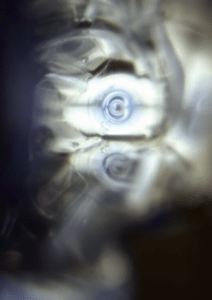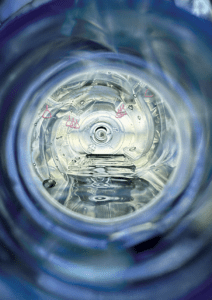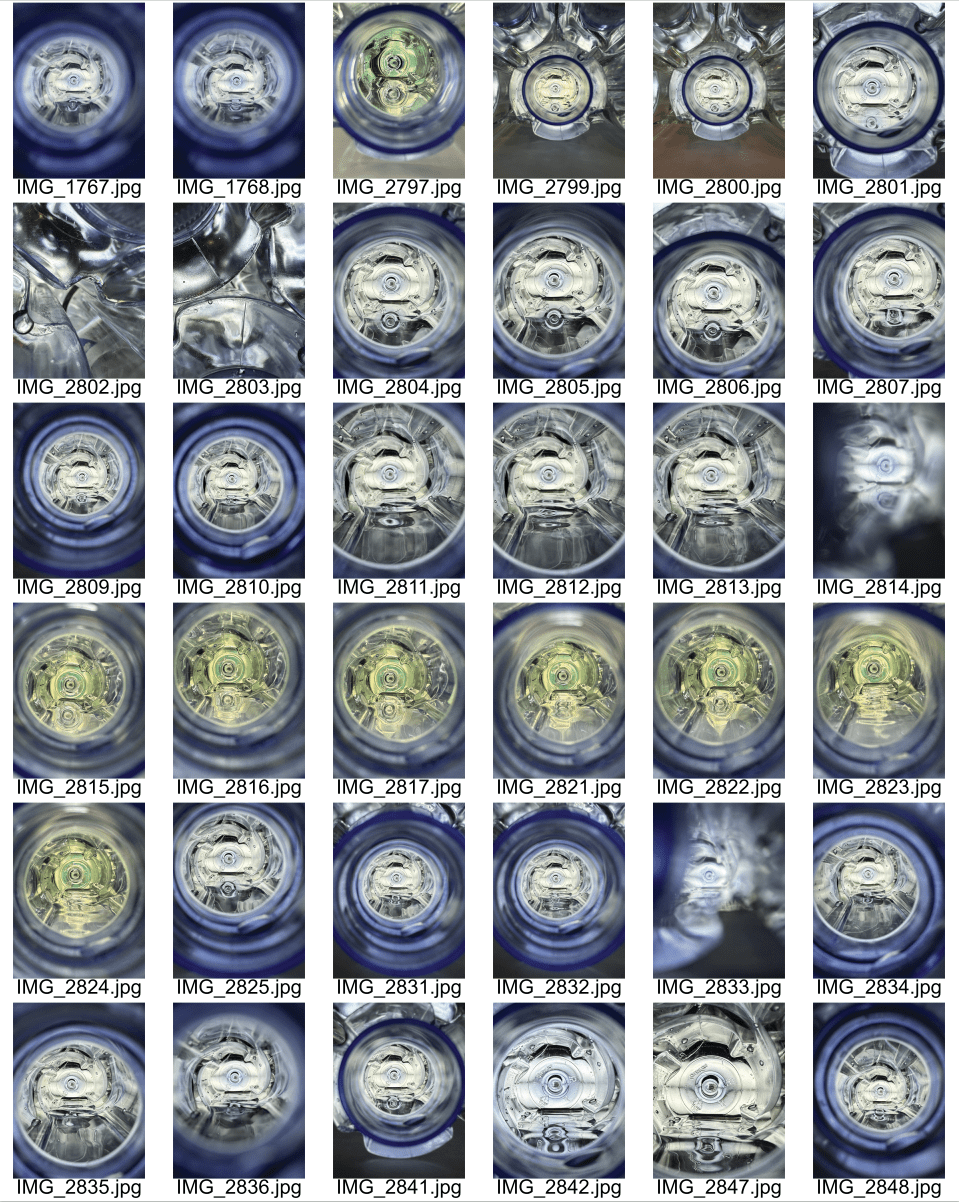Source: Own Image
Playthrough:
Echosystem – Anita Luo
1. PROPOSAL
In this week’s assignment, I am prompted to use microphones and audio filtering/manipulation skills to discover sounds in an object/site. These sounds will become creatures that live in the speculative environment that will be reconstructed in Unity. In the process of making the scene, I will deeply reflect on how the “species” of a soundscape creates its “acoustic niche” through attentive listening. Furthermore, I will note down, as Krause puts it, the density (the total number of vocal organisms) and diversity (the total number of different vocal species) of a soundscape ecosystem and its different ecological levels (biophony, geophony, and anthrophony) (28). By immersing myself in a certain object/site, I hope to think and value sounds more constructively and have a deeper intent on how sounds are placed and support each other in a space.
2. BRAINSTORMING
I intend to create a conceptual space of a water bottle as my chosen object/site. I believe that Unity opens much more opportunities for expression and documentation of space. Thus, to challenge the extent to which I can utilize a virtual space to illustrate a soundscape creatively, I planned how I would convey the sounds inside a bottle and what sounds of real-world sites I could translate into this conceptual space.

3. INSPIRATION & CONCEPTUAL INTEGRATION
Concept #1: Microscopic View of a Water Bottle
I would like to expand on my previous work called Molecular Voyage (it is still hanging outside the 3rd Floor IMA studio if you would like to check it out!) which I have also written a documentation blog on. By comparing a water bottle to a metro train I want to communicate the message that the continuation of our materialistic life has an uncertain destination. In my opinion, the manufacturing and selling of bottled water is the epitome of consumerism and waste culture. How can I convey this concept through a virtual space?


Anita Luo, Molecular Voyage, 2023, Photograph
I intend not to stop time but to track it; not to fragment space but to enlarge it; and not to tell an unmediated truth but to engage in a dialectic with others (Ritchin xx, 125).
Below is the contact sheet I made during the making of my diptych.

Keywords: Consumerism, Mitosis, Watercraft, Birth of Inventions, Uncertainty, Voyage, packaging: Consumed in Consumerism, commute, materialistic lifestyle
Concept #2: Coke Cans
More info soon.
4. PROCESS
1) Fieldwork.
a) Using a contact mic, Tascam microphone, filtering, and listening through the microphone, I experimented with different mic placements and ways of interacting with the water bottle. Firstly, I tried to capture the sound of water trickling along the sides of the bottle by pouring water from one bottle to the other.

b) I rubbed two bottle caps to create a zipper sound which made me envision an anxious hyperactive creature or a creature that is threatening.

c) I also blew through a straw to create bubble sounds which I imagined a creature that moves in a repetitive and “bubbly” manner. Other sounds I induced included tapping on the plastic bottle, blowing through the bottle hole, and recording ambiance from a computer engine (which I will edit later).

d) Once I collected my raw audio, I edited it through Audacity. For every sound, I used “Noise Reduction” to remove the background noise by first getting a noise profile and filtering out the noise.


e) When I want a certain sound to loop I would manually isolate the sound and add some “silence” at the end so that when the audio loops there is space between the sounds.


f) I wanted to create an ambiance sound within the bottle to replicate the vibrating gas that you hear when you put your ear against the hole of the water bottle. To do so, I used a “Low-Pass Filter” and “Reverb.”


g) I also experimented with filter curves to treble boost certain audios.

For the bubble sound, I changed the pitch higher as it sounded more realistic to do so.

h) Additionally, I experimented with the “High-Pass Filter” to see if the audio would sound lighter.

2) Reconstruction
a) I first constructed the bottle cap by taking photographs and importing them to Unity.


b) Using cubes I built the cap in Unity.

c) Using water blocks from the Unity Asset Store, I placed water as the floor of my scene. All assets used will be linked at the end of this section.

d) I experimented with different shaders of water.


e) I used potion objects from the Unity Asset Store for the body of the water bottle.

f) For the packaging of the water bottle I used quads on three sides of the water bottle.

g) I imported photographs that I took of the packaging into Unity and on to the three quads. Orientation had to be adjusted individually for each photograph.






h) I experimented with lighting settings and the skybox to make the scene more appealing and immersive. The undertone I wanted in the scene was purple.

I) Using assets from the Unity Asset Store, I imported creatures like crabs and squid to align with the theme of water. If I had experience with Blender, I would like to have made my own creatures with more alien features.

j) I also tested out the animations available in each package through the “Animator” function. The animations matched the mood of the sounds assigned to each creature.

k) I added bathroom reverb zones inside the water bottle so that there is a clear distinction between the external and internal space of the object when listening to sound.

l) I used the script provided by the professor in week 2 to make the crab look at the player for the whole duration. The zipper sound that I assigned to the creature is in some way intimidating so I wanted to enhance that feeling by making the crab glare at the player.

m) Lastly, I attached audio sources to their respective creatures.

I ensured that “Loop” was checked, the spatial blend was 3D and adjusted the volume rolloff to “Linear Rolloff.”





Unity Asset Store Resources
Water: https://assetstore.unity.com/packages/2d/textures-materials/water/simple-water-shader-urp-191449
Water bottle and skybox: https://assetstore.unity.com/packages/3d/props/potions-115115
Crab: https://assetstore.unity.com/packages/3d/characters/creatures/big-bat-carb-115954
Other creatures: https://assetstore.unity.com/packages/3d/characters/animals/quirky-series-free-animals-pack-178235
5. AUDIENCE RECEPTION & 6. CONCLUSIONS
Using a water bottle as my chosen object and resonant body, I discovered the many ways in which our environment and even its mundane objects within it can carry a diversity of sounds and transduced sounds. I hope that through this assignment the audience is able to appreciate and be more conscious of the little things in life and how they can bring about unique qualities. In the future, I would like to extend my scope by paying more attention to soundscape ecology in terms of identifying and investigating the biophony, geophony, and anthrophony layers of a specific site. My intention to focus on biophonies specifically is also “to reconnect to the potent sonic elixirs found in our remaining wild soundscapes…to think of and value natural sound in constructive ways” (Krause 38). Furthermore, I would like to use Adobe Audition, with its more versatile features, to experiment with adjusting sounds to make alien audio sources discernible from each other. During the class check-in, my partner could only separate a few audio sources from each other due to the similarity between all the audio. I hope to tackle this problem in the next activity where I will edit sounds of distinct timbres that also fit into their own acoustic niche.
7. APPENDIX
None.
8. REFERENCES
Krause, Bernie. Wild Soundscapes Ch. 2, 14 Feb. 2020, https://doi.org/10.12987/9780300221114.
Ritchin, Fred. In Our Own Image: The Coming Revolution in Photography. Aperture.
